In 2022, nonprofit arts and culture organizations and their audiences generated $151.7 billion in economic activity—$73.3 billion in spending by the organizations, which leveraged an additional $78.4 billion in event-related spending by their audiences. The impact of this economic activity is far reaching, supporting 2.6 million jobs, generating $29.1 billion in tax revenue, and providing $101 billion in personal income to residents. The study highlights the not always recognized economic power of creative non-profit cultural organizations in America.
The newly released Arts & Economic Prosperity 6 (AEP6) by Americans for the Arts is an economic and social impact study of the nation’s nonprofit arts and culture industry. Building on its 30-year legacy as the largest and most inclusive study of its kind, AEP6 provides detailed findings on 373 regions from across all 50 states and Puerto Rico—ranging in population from 4,000 to 4 million—and representing rural, suburban, and large urban communities. The organizations that supported and helped with this study, include:
- Actors’ Equity Association
- African Diaspora Consortium
- Arts & Planning Division (American Planning Association)
- Black Legislative Leaders Network
- Department for Professional Employees, AFL-CIO (American Federation of Labor and Congress of Industrial Organizations)
- Destinations International
- International City/County Management Association
- Independent Sector
- National Association of Counties
- National Conference of State Legislatures
- National Alliance of Community Economic Development Associations
- National Independent Venue Association
- National Organization of Black Elected Legislative Women
- Race Forward
- Recording Industry Association of America
- The Conference Board
- U.S. Conference of Mayors
“The AEP6 report underscores what businesses across the nation have witnessed – that investments in arts and culture not only enhance the quality of life, but also stimulate economic development. By supporting the arts, companies attract and retain talent and create an environment where creativity, businesses, and communities thrive,” said Paul Washington, Executive Director, ESG Center, The Conference Board
“Mayors understand the connection between the arts industry and city revenues. Arts activity creates thousands of direct and indirect jobs and generates billions in government and business revenues. The arts also make our cities destinations for tourists, help attract and retain businesses, and play an important role in the economic revitalization of cities and the vibrancy of our neighborhoods,” Mayor Hillary Schieve (Reno); President, The United States Conference of Mayors
In addition to the initial takeaway above, here are the rest of the top takeaways from the report:
-
-
- Nonprofit arts and culture organizations are businesses. They employ people locally, purchase supplies and services from nearby businesses, and engage in the marketing and promotion of their cities and regions. Their very act of doing business— creating, presenting, exhibiting, engaging—has a positive economic impact and improves community well-being. Nonprofit arts and culture organizations spent an estimated $73.3 billion which supported 1.6 million jobs and generated $18.3 billion in local, state, and federal government revenue.
- Arts and culture drives commerce to local businesses. When people attend a cultural event, they often make an outing of it—dining at a restaurant, paying for parking or public transportation, enjoying dessert after the show, and returning home to pay for child or pet care. Attendees at nonprofit arts and culture events spend $38.46 per person per event, beyond the cost of admission—vital income for local merchants and a value-add that few industries can compete with.
- Arts and culture strengthens the visitor economy. One-third (30.1%) of attendees travel from outside the county in which the activity takes place; they spend an average of $60.57, twice that of their local counterparts ($29.77). Three-quarters (77%) of nonlocal attendees reported that the primary purpose of their visit was to attend that cultural event.
- A vibrant arts and culture community keeps residents spending locally. When local attendees to nonprofit arts and culture events were asked what they would have done if the event where they were surveyed had not been available, 51% said they would have “traveled to a different community to attend a similar arts or cultural activity.”
- Spending by attendees to BIPOC and ALAANA events reflect national spending. Attendees at organizations serving a community of color spend an average of $38.29 per person per event— virtually identical to the overall national average of $38.46. Attendees to BIPOC and ALAANA events from outside the county represented 27.8% of the audiences (nationally it was 30.1%). Even the spending by nonlocal attendees to BIPOC and ALAANA organizations was nearly identical to the national average ($58.98 and $60.57, respectively).
- Pride in community. 89% of attendees agreed that the activity or venue they were attending was “a source of neighborhood pride for the community.” 86% said they would “feel a sense of loss if that activity or venue was no longer available,” and 86% felt it important that future generations also be able to have that cultural experience.
- Arts and culture build more livable communities. 86% of Americans say, “arts and culture are important to their community’s quality of life and livability,” and 79% of the American public believe that the arts are “important to their community’s businesses, economy, and local jobs.”
- Improving personal well-being. 78% of the population say the arts are a “positive experience in a troubled world,” 69% of the population believe the arts “lift me up beyond everyday experiences,” and 71% feel the arts give them “pure pleasure to experience and participate in.”
- Building empathy and understanding. 72% of Americans believe, “The arts provide shared experiences with people of different races, ethnicities, ages, beliefs, and identities (gender, political, national origin),” and 73% agree that the arts “helps me understand other cultures better.”*
- Post-COVID audiences spent more, traveled less. Nationally, per person event-related spending increased from $31.47 to $38.44 in the years between AEP5 and AEP6 (2016 and 2022)—a 22% increase, matching the rate of inflation during that period. The percentage of nonlocal attendees (coming from outside the county in which the event took place) decreased from 34% in AEP5 to 30% in AEP6 (-11.5%).
- Arts spark creativity and innovation. “Creativity” is among the top five applied skills sought by business leaders—per the Conference Board’s Ready to Innovate report—with 72% saying creativity is of “high importance” when hiring. For the second year in a row, “creativity” tops the list as the #1 soft skill needed in business (LinkedIn)
-
“As the world’s largest and most reliable resource for destination organizations, arts and culture organizations make up the beautiful tapestry of what makes destinations come alive. Advocacy, especially at the local level, and data from the AEP6 research partners empower destination to not just showcase their beauty but to measure the impact of creativity, fostering a vibrant, sustainable future for all to explore and cherish,” said Sophia Hyder Hock, Chief Diversity Officer Destinations International
“As a social and cultural entrepreneur, I have witnessed the importance of informing our BIPOC and foreign-born communities about our impact and contributions to the economy. Having access to this comprehensive and thorough study will allow grassroots and established organizations to quantify and see the financial benefits of growing and diversifying audiences, as well as acknowledging their contributions towards building and sustaining our cultural movements. I look forward to continuing to support the advocacy efforts and demonstrating with data how arts and cultures create attractive places to live, work, and become creative, fulfilled, and productive citizen artists. AEP6 will be a valuable tool in sharing that message,” said Angie Durell, Founder and CEO, INTEMPO and AEP6 Equity Task Force member
“Music and the arts are the foundation of vibrant communities and help us connect, understand, and inspire one another. All while driving economic growth, creating rewarding jobs and careers, and powering our culture forward. Americans for the Arts’ latest Arts and Economic Prosperity report does a vital service documenting the facts on the ground of the U.S. creative and nonprofit economy and offers valuable lessons and opportunities for communities seeking to boost their own arts footprint and activities,” said Mitch Glazier, Chairman and CEO, Recording Industry Association of America
The mission of Americans for the Arts is to build recognition and support for the extraordinary and dynamic value of the arts and to lead, serve, and advance the diverse networks of organizations and individuals who cultivate the arts in America. For full background on this comprehensive report, go to American for the Arts AEP 6 Report.
Compiled by Victoria Larson, Side of Culture


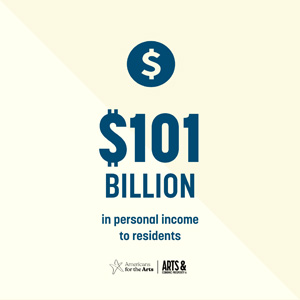
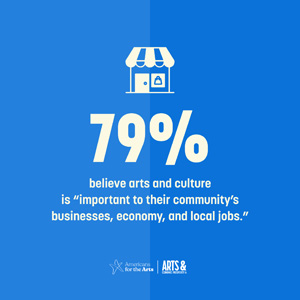
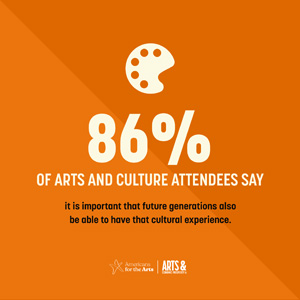
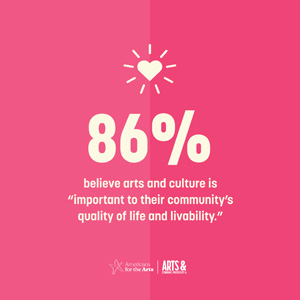
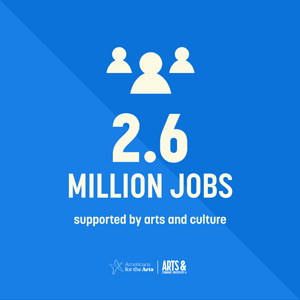
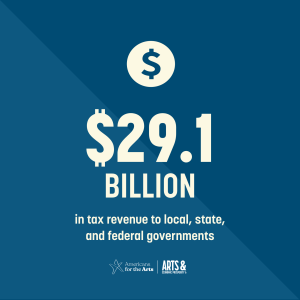

1 Comment